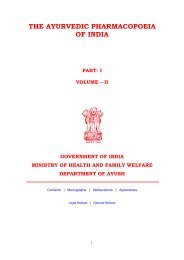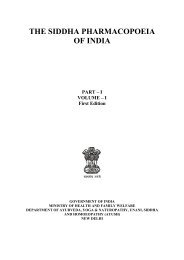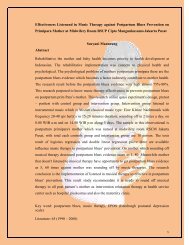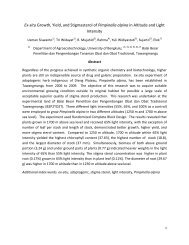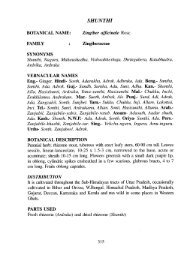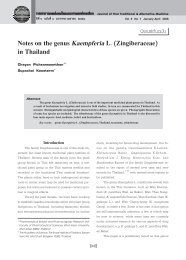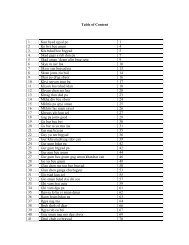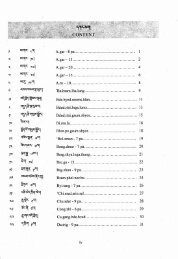Vetiveria Zizanioides (L.) - HerbalNet Digital Repository
Vetiveria Zizanioides (L.) - HerbalNet Digital Repository
Vetiveria Zizanioides (L.) - HerbalNet Digital Repository
You also want an ePaper? Increase the reach of your titles
YUMPU automatically turns print PDFs into web optimized ePapers that Google loves.
cultivation. Vetiver is raised from live mot slips planted in field during rainy season. A<br />
fully grown root clump is divided into 15-20 cm long rooted slips and these are<br />
planted in rows at 60 x 25 cm spacing to allow 6000 plants per hectare. The freshly<br />
planted field is given a light irrigation if it does not rain in next one or two days of<br />
planting; these slips commence sprouting in 7 to 10 days. The planted crop is earthed<br />
up after 60 days and the ridges are made 30 cm broad and 20 cm high which facili-<br />
tates higher root development. The initial growth of sprouted vetiver is slow for first<br />
90 days. The first interculture is recommended at 30 days after sprouting. Two more<br />
intercultms are given to the crop, viz., the first in February, when the plants resprout<br />
in the spring and the next in July. The use of chemical weedicides and one pre-emer-<br />
gence spraying of atrazine or oxadizone controls weed growth for first 60 to 70 days.<br />
Fertilizers like EYM, P,O,, 60 and nitrogen help in better root yield. Leaf blight<br />
caused by Cuwularia trifolii is the most serious fungal disease which affects the<br />
vetiver plants. Two to three spraying of copper fungicide (3%) containing 50% metallic<br />
copper at the rate of 550 to 725 literha is recommended as a control measure. Crop<br />
can be dug out between the age of 15 to 18 months. The aerial parts of the growing<br />
plants are cut off from ground level, the roots are dugout and cleared of mud by<br />
washing. After cleaning, the mots are separated fbm stump part and dried in shade for<br />
5 to 7 days to allow it to contain only about 10% moisture. Freshly harvested roots<br />
give higher oil yield over stored air-dried mots.<br />
During, tissue culture studies embryogenic callus was induced h m immature inflores-<br />
cence segments of K zizinwides on Murashige & Skoog's medium supplemented with<br />
2,4 dichlomphenoxyacetic acid (3.5 mg/l) and kinetin (0.5- 1 mg/l). The callus on sub<br />
culture to media with no hormones or low levels of 2,; ' (I mgA) developed a large<br />
number of embryoids, which developed into plantlets on the basal medium or on trans-<br />
fer to MS medium with low levels of auxins. The regenerated plantlets developed a<br />
strong root system on MS medium with NAA (1 mgA).<br />
Callus induction and high frequency regeneration was achieved from mesocotyl<br />
parts of young seedlings of vetiver when cultured on MS medium supplemented<br />
with 2,4-D and kinetin. Shoot formation occurred from 40-50 days old pale yel-<br />
low, nodular callus when subcultured on MS basal medium or MS medium aug-<br />
mented with BA. Rooting of shoots occurred in MS medium supplemented with<br />
NAA. Plantlets were then transferred to soil for acclimatization.<br />
In another trial the explants of young sheath and in vitro basal shoot fragments of<br />
vetiver were used to study the somatic embryogenesis and shoot formation. The<br />
results showed that auxin was the key factor for the induction of somatic embryo-<br />
genesis from the explants. Shoot organogenesis originated from the germination of<br />
somatic embryos which could be induced on induction media supplemented with<br />
NAA or low concentration of 2,4-D. An efficient recycle induction, regeneration



